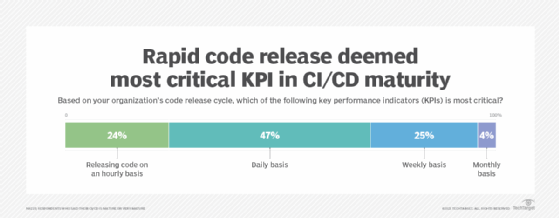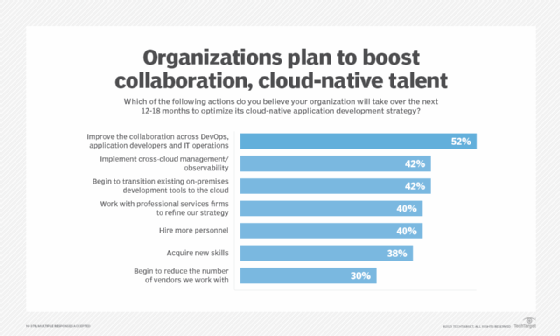
Getty Images/iStockphoto
Cloud-native development still a work in progress for companies
Enterprise Strategy Group's Paul Nashawaty breaks down the research firm's latest survey on the state of cloud-native application development. The picture isn't perfect.
Digital transformation usually involves moving some business processes to the cloud, which then requires buying or building applications that take advantage of the cloud's flexibility and economies of scale.
Such cloud-native applications often place major demands on organizations to modernize their application environments by replacing much of their older, on-premises infrastructure with cloud services and integrating the two. A survey report, "Distributed Cloud Series: The Mainstreaming of Cloud-native Apps and Methodologies," by TechTarget's Enterprise Strategy Group (ESG) shows that while cloud-native architectures have become mainstream, many organizations are midway through the necessary improvements.
The survey asked 378 DevOps, application development (app dev) and IT professionals in the U.S. and Canada about their use of cloud-native application development and the challenges they face in deploying applications across distributed cloud environments. A third of the respondents reported building and deploying cloud-native applications using a traditional deployment approach. Other results suggest the percentage will shift dramatically in the next two years to deployment via microservices.
In this Q&A, ESG analyst Paul Nashawaty explains the trends surrounding the survey and what the results say about the maturity of cloud-native application development initiatives. Nashawaty has experience executing front- and back-end digital transformations and the infrastructure modernization needed to support them.
Editor's note: The following was edited for length and clarity.
What was ESG trying to learn from the survey?
 Paul Nashawaty
Paul Nashawaty
Paul Nashawaty: We were trying to identify the opportunities and use cases of cloud-native deployments as well as the roadblocks and monitoring the landscape.
We are known as a research firm that focuses on IT issues. Cloud native is more of a DevOps or app dev issue. While we were interested in understanding the IT response, we also wanted to get the perspective of professionals responsible for evaluating, purchasing, managing and building application infrastructures.
Cloud-native application development is not a one-sided situation where IT puts something in place and that's it. It is a collaborative approach across the DevOps and app dev personas, who were 60% of the respondents; 40% were from IT.
When we talked to organizations about the percentage of time they spend on development tasks, 37% said they spend it on innovating or creating new software, 30% on modernizing applications for cloud-ready and cloud-native deployments, and 33% on maintenance. If organizations are spending 37% of their time innovating, that probably means they still have application development cycles that they have to modernize.
Can you say more about how they're modernizing their applications?
Nashawaty: Organizations can have applications that live in any of five different phases.
The first phase is traditional or heritage applications that are running in a monolithic environment, independent of any real integration other than maybe at the application level.
The next phase is to take those heritage applications and encapsulate them into a virtual machine. You have more portability and accessibility of the application. You can move it around; you can move to the cloud. You can do what you want with it.
From there, many organizations will take the virtual machine and roll it into a fat container, which allows for ecosystem orchestration using something like Kubernetes, OpenShift or Tanzu in a modernized orchestration layer to move the application to the appropriate resources across the appropriate cloud. Ninety-four percent of survey respondents indicated that they're running on two or more clouds. If you don't have an orchestration layer that manages across these clouds, it becomes difficult and complex.
The fourth stage of the application journey is when you take the fat container and those applications and move them into microservices. We can see today that 79% of respondents say they are using containers and 81% indicate they're using or plan to use containers in the next two years. Microservices architectures are being used to deliver those new, modernized applications.
The final, kind of utopian phase that a lot of organizations want to get to is a fully elastic cloud environment. Eighty-seven percent of respondents said application portability is either critical or very important to their organization.
If you have full elasticity and utilize the cloud to its fullest capabilities, you can move applications in your cloud-native ecosystem across public clouds, edge locations, private clouds, data centers, et cetera.

What were the main takeaways from the survey?
Nashawaty: What organizations need to understand is, to go on this journey and understand their cloud-native strategy, they need to understand how their organization is currently positioned and what tools, people, processes and technologies they're using.
We found that organizations are heavily leveraging DevOps methodologies. It increased from 27% in 2022 to 35%.
We also asked organizations that are using the CI/CD [continuous integration, continuous delivery] pipeline how mature they thought they were. Thirty-one percent said they were very mature and 46% said they're mature.
We wanted to understand this a little bit more, so we asked what their KPIs are [Figure 1]. Twenty-four percent indicated that they need to release code on an hourly basis and 47% need to release code on a daily basis.
What percentage do you think indicated they can release code on an hourly basis? Eight percent. They're not meeting their business KPIs, and they're not modernizing.
On the bright side, there's an increase in agile methodologies and DevOps from 26% in 2022 to 34% using it in 2023; 38% use GitOps. The organizations that use DevOps, agile methodologies and GitOps have the most success at releasing code hourly or several times a day.
Can you drill down into spending plans?
Nashawaty: The bottom line is 94% of respondents indicate that their organization will be increasing cloud-native spend over the next 12 to 18 months. If your organization is not doing this, you're going to be at a competitive disadvantage.
The other point is about where their money is being spent [Figure 2]. Forty percent are working with a service provider to refine their strategy.
That's a staff augmentation approach. Forty percent also said they will hire more personnel; they're trying to onboard new people and new skills. Those are areas looking to be refined.
One other interesting thing is that 52% of respondents indicated that they want to improve collaboration across DevOps, app dev and IT. We found last year that the infinity loop of the CI/CD pipeline was more like a circle. You had the delivery and the deployment -- the CD part -- but the CI part was not being implemented.
One of the main areas not being implemented was testing. Last year, only 29% of respondents indicated that they do automated testing or continuous testing within their CI/CD pipeline. This year, it jumped up to 66%. That's a type of collaboration across the organization.
The reason organizations were not testing is they were testing as part of the release cycle. When the customer saw a bug, they were fixing it. As part of agile development, you end up having sprint reviews, and 22% of organizations do them daily and 53% weekly.
What ends up happening is, when a sprint review comes through, a bug is identified and addressed in the next release. This is not a good process. It's a dangerous game to play with your customer retention -- to let your customers test the product.

Were there any other surprises?
Nashawaty: The use of open source was a little bit of a surprise. From 82% in 2022, we saw the use of open source -- organizations that want to purchase paid support from the same vendor who sponsors an open-source project -- drop to 64% in 2023. In my opinion, that went in the wrong direction.
As much as organizations say they want to be vendor agnostic as well as have no vendor lock in and an open environment, their words do not match the results of the survey. It shows that in 2022, 14% of respondents indicated that they wanted a vendor-agnostic approach. In 2023, it was 36%. It more than doubled.
My analysis is that organizations don't want to go at it alone. They want to make sure they have the support of a vendor. A banking organization is not in the business of writing apps. If they run into a problem, they want to make sure they have a vendor they can go to.
Are any other trends in cloud-native apps shown in the survey results?
Nashawaty: One of the things we saw trending year over year was how much IT decision makers believed their C suites viewed the app dev team as valuable. In 2022, 42% of the respondents indicated that they viewed app dev as a high-value service provider. That dropped 12 points to 30% in 2023.
However, the big surprise is that app dev teams are nonetheless viewed as a source of business growth, going from 6% in 2022 to 22% in 2023. Respondents also view the app dev team as a competitive differentiator, jumping from 13% to 20% year over year.
The app dev team is viewed as the way the business will grow. They are no longer viewed as purely tactical executioners.
Do you have any closing advice?
Nashawaty: If your organization is not willing to modernize, you're going to be left behind. Truly understanding the stages of your business objectives is key. If you view yourself as a mature or very mature organization, be critical of your self-awareness about what you deliver.
Read the full survey results
Enterprise Strategy Group subscribers can click here for a report on the survey covered in this Q&A.







